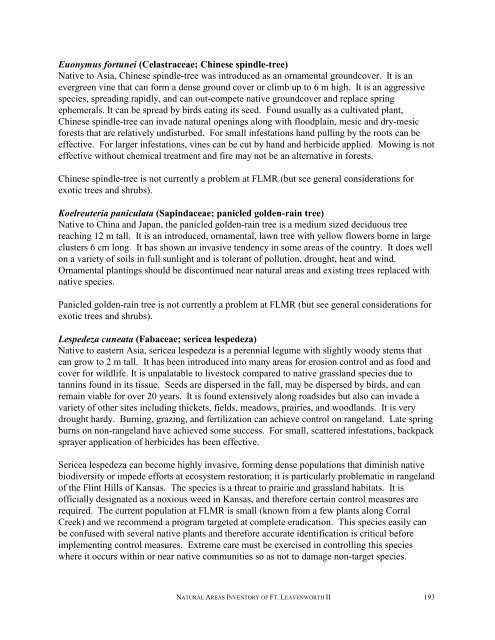A Natural Areas Inventory of the - Kansas Natural Heritage Inventory ...
A Natural Areas Inventory of the - Kansas Natural Heritage Inventory ...
A Natural Areas Inventory of the - Kansas Natural Heritage Inventory ...
You also want an ePaper? Increase the reach of your titles
YUMPU automatically turns print PDFs into web optimized ePapers that Google loves.
Euonymus fortunei (Celastraceae; Chinese spindle-tree)<br />
Native to Asia, Chinese spindle-tree was introduced as an ornamental groundcover. It is an<br />
evergreen vine that can form a dense ground cover or climb up to 6 m high. It is an aggressive<br />
species, spreading rapidly, and can out-compete native groundcover and replace spring<br />
ephemerals. It can be spread by birds eating its seed. Found usually as a cultivated plant,<br />
Chinese spindle-tree can invade natural openings along with floodplain, mesic and dry-mesic<br />
forests that are relatively undisturbed. For small infestations hand pulling by <strong>the</strong> roots can be<br />
effective. For larger infestations, vines can be cut by hand and herbicide applied. Mowing is not<br />
effective without chemical treatment and fire may not be an alternative in forests.<br />
Chinese spindle-tree is not currently a problem at FLMR (but see general considerations for<br />
exotic trees and shrubs).<br />
Koelreuteria paniculata (Sapindaceae; panicled golden-rain tree)<br />
Native to China and Japan, <strong>the</strong> panicled golden-rain tree is a medium sized deciduous tree<br />
reaching 12 m tall. It is an introduced, ornamental, lawn tree with yellow flowers borne in large<br />
clusters 6 cm long. It has shown an invasive tendency in some areas <strong>of</strong> <strong>the</strong> country. It does well<br />
on a variety <strong>of</strong> soils in full sunlight and is tolerant <strong>of</strong> pollution, drought, heat and wind.<br />
Ornamental plantings should be discontinued near natural areas and existing trees replaced with<br />
native species.<br />
Panicled golden-rain tree is not currently a problem at FLMR (but see general considerations for<br />
exotic trees and shrubs).<br />
Lespedeza cuneata (Fabaceae; sericea lespedeza)<br />
Native to eastern Asia, sericea lespedeza is a perennial legume with slightly woody stems that<br />
can grow to 2 m tall. It has been introduced into many areas for erosion control and as food and<br />
cover for wildlife. It is unpalatable to livestock compared to native grassland species due to<br />
tannins found in its tissue. Seeds are dispersed in <strong>the</strong> fall, may be dispersed by birds, and can<br />
remain viable for over 20 years. It is found extensively along roadsides but also can invade a<br />
variety <strong>of</strong> o<strong>the</strong>r sites including thickets, fields, meadows, prairies, and woodlands. It is very<br />
drought hardy. Burning, grazing, and fertilization can achieve control on rangeland. Late spring<br />
burns on non-rangeland have achieved some success. For small, scattered infestations, backpack<br />
sprayer application <strong>of</strong> herbicides has been effective.<br />
Sericea lespedeza can become highly invasive, forming dense populations that diminish native<br />
biodiversity or impede efforts at ecosystem restoration; it is particularly problematic in rangeland<br />
<strong>of</strong> <strong>the</strong> Flint Hills <strong>of</strong> <strong>Kansas</strong>. The species is a threat to prairie and grassland habitats. It is<br />
<strong>of</strong>ficially designated as a noxious weed in <strong>Kansas</strong>, and <strong>the</strong>refore certain control measures are<br />
required. The current population at FLMR is small (known from a few plants along Corral<br />
Creek) and we recommend a program targeted at complete eradication. This species easily can<br />
be confused with several native plants and <strong>the</strong>refore accurate identification is critical before<br />
implementing control measures. Extreme care must be exercised in controlling this species<br />
where it occurs within or near native communities so as not to damage non-target species.<br />
NATURAL AREAS INVENTORY OF FT. LEAVENWORTH II 193


